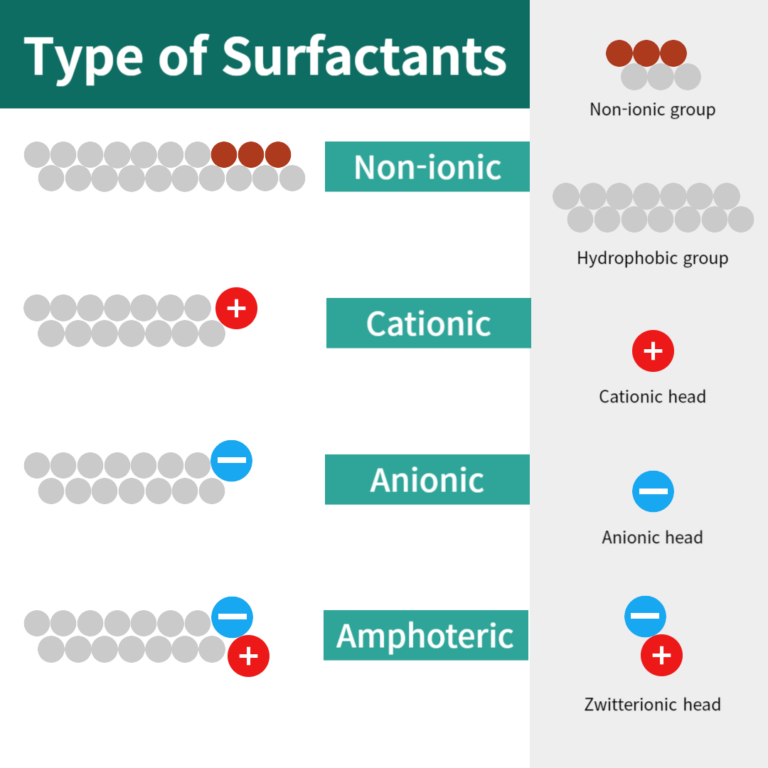How to Find the Best Shampoo for Hair Loss?
The most important component in a shampoo is said to be the surfactant. Let's find out what surfactants are and which types are better suited for people with hair loss.

Surfactants, short for surface-active agents, are fascinating molecules that play a crucial role in everyday products, including shampoos. They possess a unique dual nature, having both hydrophobic (water-hating) and hydrophilic (water-loving) properties. This remarkable characteristic allows them to act as intermediaries between water and oil, substances that naturally repel each other.
In science, the property of repelling water is called hydrophobic, while the property of attracting water is called hydrophilic. As shown in the figure, one side, represented by the long hydrocarbon chain (red section in the diagram), is the hydrophobic side. This part is composed of carbon and hydrogen atoms that share electrons evenly, creating nonpolar covalent bonds. As a result, it doesn’t interact well with polar water molecules. In contrast, the other end of the surfactant molecule, represented by the polar group (blue circle in the diagram), is the hydrophilic side. This part typically carries a charge (positive or negative) or has an uneven distribution of electrons, creating polarity. This polarity allows it to form bonds with the polar water molecules. Therefore, when oil and grease are not easily washed away by water, adding a surfactant helps because the hydrophobic parts of the surfactant bind to the oil and grease, while the hydrophilic groups at the surfactant’s end bind with water. This makes it easier to dissolve and remove the oil and grease. This is the principle behind soap as a cleaner for removing oil and grease.

Surfactants, as depicted in the diagram, are categorized into four main types based on their molecular characteristics. Among these, cationic and anionic surfactants exhibit superior cleansing power, effectively generating abundant lather to remove oily residue. However, it’s crucial to note that these surfactants, particularly cationic surfactants represented by quaternary ammonium compounds (polyquaternium-10, polyquaternium-18, ester quats) and anionic surfactants (sodium lauryl sulfate, ammonium lauryl sulfate, potassium cocoylglycinate), can be harsh on the skin, causing irritation.
Cationic surfactants have such exceptionally strong surfactant properties that they can disrupt microbial cell membranes and modify proteins to the extent that they can be used as synthetic antimicrobial agents. Sodium lauryl sulfate (SLS or SDS), an anionic surfactant commonly used in various products, is known for its low cost, abundant foam production, and exceptional cleansing power. However, this surfactant comes with a significant drawback: it can cause significant skin irritation. Studies have demonstrated that even a mere 0.3% solution of SLS in water, when applied to the skin, can induce redness, blotchy patches, and a tingling sensation within just 10 hours.

Sulfate-based surfactants, also known as SLS or SDS surfactants, are a common type of surfactant characterized by their sulfate group (SO4-) attached to the end of their molecular structure. These surfactants are widely used in various industries, including cosmetics, personal care, and household cleaning products, due to their strong cleansing power and ability to generate abundant foam. However, sulfate-based surfactants have been associated with potential skin irritation, particularly for individuals with sensitive scalps. This is because their strong negative charge can disrupt the scalp’s natural barrier, making it more susceptible to dryness and irritation.
For individuals experiencing hair loss or those with sensitive scalps, it is crucial to prioritize gentle cleansing and minimize scalp irritation. While sulfate-based surfactants offer strong cleansing power, their potential for irritation may outweigh their benefits. In such cases, choosing mild shampoos formulated with non-ionic surfactants is recommended. Non-ionic surfactants offer gentle cleansing without compromising scalp health. While their cleansing power may be milder compared to sulfate-based surfactants, they effectively remove dirt, oil, and impurities without causing irritation.

In conclusion, when it comes to shampoos, it is recommended to include non-ionic surfactants with minimal scalp irritation if possible. If the cleansing power is inadequate and dandruff or other oils are not effectively removed, it is advisable to actively consider shampoos containing amphoteric surfactants. Particularly, non-ionic surfactants processed from natural materials may have slightly lower cleansing power but are gentle and less irritating to the scalp, which is beneficial for those experiencing hair loss. Moreover, ideally, shampoo with a slightly acidic pH, which is close to the natural acidity of the scalp, would be optimal.











